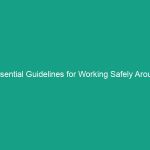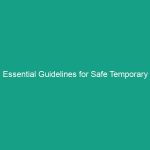Introduction
Good morning team,
Today, we’re diving into a crucial topic that affects all of us in our daily operations: Essential Doffing Guidelines: Avoid Critical Mistakes in Safety Protocols. Proper doffing Procedures are vital in maintaining our Safety and health Standards on-site, especially when dealing with hazardous materials or equipment. Understanding and following these guidelines can prevent accidents and ensure a safer workplace.
Understanding Essential Doffing Guidelines
So, what exactly are doffing guidelines? In simple terms, doffing refers to the proper method of removing Personal Protective Equipment (PPE) and clothing to prevent contamination and exposure to hazardous substances. It’s not just about taking off your gear; it’s about doing it correctly to protect yourself and your colleagues.
Many employees may underestimate the importance of doffing correctly, thinking that as long as they wear PPE, they are safe. However, improper doffing can lead to serious contamination risks and exposure to harmful substances. It’s essential to recognize that doffing is just as critical as donning (putting on) protective equipment.
Key Hazards, Risks, and Safety Considerations
When it comes to doffing, several Hazards and risks must be addressed:
- Contamination: Improper removal of PPE can lead to skin contact with hazardous substances.
- Inhalation Risks: If not done correctly, doffing can release airborne contaminants.
- Cross-Contamination: Transferring hazardous substances from PPE to clean areas or other personnel.
Ignoring these risks can result in serious health issues, including respiratory problems, skin diseases, or even long-term chronic illness. It’s crucial to understand that these consequences can affect not only the individual but also the entire team and workplace Environment.
Best Practices, Procedures, & Actionable Advice
Let’s go over the Best Practices for doffing PPE to minimize risks and ensure a safe environment:
Step-by-Step Doffing Procedures
1. **Prepare the Area:** Ensure you have a designated doffing area, away from clean zones. This area should be equipped with disposal containers for contaminated gear.
2. **Wash Your Hands:** Before removing any PPE, wash your hands thoroughly with soap and water or use hand sanitizer.
3. **Remove Gloves:** Grasp the outside of one glove with the opposite gloved hand and peel it off. Hold the removed glove in the gloved hand, then slide a finger under the cuff of the remaining glove and peel it off, trapping the first glove inside the second. Dispose of them in the designated waste container.
4. **Remove Gown or Apron:** Untie or unfasten the gown/apron and remove it, ensuring the outside does not touch your skin. Roll it inward and place it in the disposal container.
5. **Remove Face Shield or Goggles:** Handle the face shield or goggles by the headband, avoiding contact with the front surface. Dispose of them appropriately if they are single-use.
6. **Remove Respirator or Mask:** If using a respirator, remove it by the straps without touching the front. Dispose of it as per the guidelines.
7. **Final Hand Wash:** Wash your hands again after removing all PPE to eliminate any lingering contaminants.
Real-Life Examples
Consider the case of a healthcare worker who neglected proper doffing procedures after attending to a patient with an infectious disease. By not following the guidelines, they inadvertently contaminated their uniform and transmitted the infection to others. This incident underscores the importance of adhering to strict doffing protocols.
Regulations, Standards, and Compliance
Compliance with established Regulations is essential in maintaining safety standards. Organizations like OSHA provide guidelines on PPE usage, including donning and doffing procedures. Adhering to these regulations not only protects employees but also helps companies avoid legal repercussions and ensures a safe working environment.
Remember, compliance is not optional; it is a critical part of our safety culture. Each of us has a role to play in upholding these standards.
Employee Engagement & Discussion
Now, I want to hear from you. Have you ever faced challenges while doffing PPE? Were there specific situations where you felt unsure about the correct procedures? Open discussions can lead to better understanding and improvements in our safety practices.
Conclusion & Key Takeaways
In summary, proper doffing procedures are essential in avoiding critical mistakes in safety protocols. By understanding the importance of these guidelines and implementing Best Practices, we can protect ourselves and our colleagues from potential hazards.
Let’s prioritize safety in our workplace by ensuring that we all follow the doffing guidelines diligently. Thank you for your attention and commitment to making our work environment safer for everyone.


